| Article ID | Journal | Published Year | Pages | File Type |
|---|---|---|---|---|
| 6485918 | Biomaterials | 2015 | 11 Pages |
Abstract
Endogenous hypochlorite ion (ClOâ) is a highly reactive oxygen species (ROS) that is produced from hydrogen peroxide and chloride ions catalyzed by myeloperoxidase (MPO). And mitochondrion is one of the major sources of ROS including ClOâ. In the present work, a two-photon phosphorescent probe for ClOâ in mitochondria was developed. An iridium(III) complex bearing a diaminomaleonitrile group as ClOâ reactive moiety specifically responded to ClOâ over other ions and ROSs. When the probe was reacted with ClOâ to form an oxidized carboxylate product, a significant enhancement in phosphorescence intensity was observed under one-photon (402 nm) and two-photon (750 nm) excitation, with a two-photon absorption cross-section of 78.1 GM at 750 nm. More importantly, ICP-MS results and cellular images co-stained with Mito-tracker Green demonstrated that this probe possessed high specificity for mitochondria. This probe was applied in the one- and two-photon imaging of ClOâ in vitro and in vivo. The results suggested endotoxin lipopolysaccharide (LPS) induced ClOâ mostly generated in the liver of zebrafish.
Related Topics
Physical Sciences and Engineering
Chemical Engineering
Bioengineering
Authors
Guanying Li, Qian Lin, Lingli Sun, Changsheng Feng, Pingyu Zhang, Bole Yu, Yu Chen, Ya Wen, Hui Wang, Liangnian Ji, Hui Chao,
